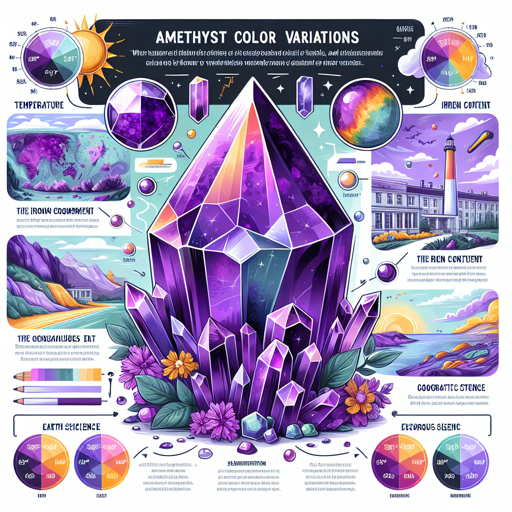The Spectacular Spectrum of Amethyst Color Variations
Uncovering the factors that create the stunning color variations in the beloved Amethyst gemstone.

Introduction
Amethyst, a breathtaking gemstone that has captivated humanity for centuries with its spectrum of shades ranging from deep purple to delicate lavender, is a truly fascinating specimen in the world of minerals. Renowned for its beauty and the calming aura it exudes, the color variations of Amethyst have long been a subject of interest to geologists, gemologists, and mineral enthusiasts alike. This article explores the underlying factors that cause these color variations in Amethyst.
The Science of Color in Amethyst
The color variations in Amethyst are primarily the result of two factors: the presence of iron in the crystal structure and exposure to natural radiation. Let’s explore these factors in more detail.
Iron Content
Iron is a trace element in Amethyst. When present, it can influence the color of the gemstone. The iron ions in Amethyst absorb certain wavelengths of light, affecting the color we perceive when we look at the gemstone.
| Iron Content | Resulting Color |
|---|---|
| Low | Pale Lavender |
| High | Deep Purple |
Radiation Exposure
Natural radiation from the surrounding rock or soil can also alter the color of Amethyst. When the iron in Amethyst is exposed to radiation, it undergoes changes that can darken the gemstone’s hue.
The Influence of Heat
Heat can also play a role in the color variation of Amethyst. When exposed to heat, Amethyst can lighten or change color altogether, becoming a yellow-orange citrine or a green prasiolite. This process is often used in gemstone treatments to create desirable colors.
The Impact of Geographical Location
Different geographical locations can produce Amethyst with distinct color characteristics. For instance, Amethyst from Uruguay is known for its deep purple color, whereas Amethyst from Brazil tends to be lighter in color.
“The color of Amethyst holds the history of its formation, its journey from the depths of the earth, and the influences it encountered along the way.” - Anonymous
Conclusion
Understanding the factors that cause the color variation in Amethyst not only provides insight into this beautiful gemstone but also offers a fascinating glimpse into the dynamic forces at work in the mineral world. The interplay of elements, radiation, heat, and geographical location sings a complex song of creation, resulting in the spectacular spectrum of Amethyst colors we admire today.
To learn more about Amethyst and its color variations, visit the Gemological Institute of America’s page on Amethyst.
The beauty of Amethyst lies not only in its stunning array of colors but also in the stories these colors tell. Each hue is a chapter in the Amethyst’s unique journey from the depths of the earth to the palm of your hand. By appreciating these color variations, we deepen our connection to the natural world and its magnificent creations.